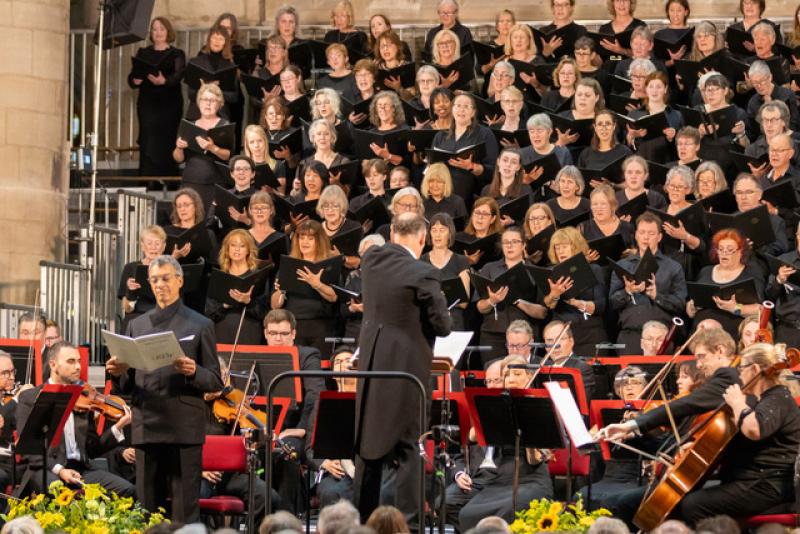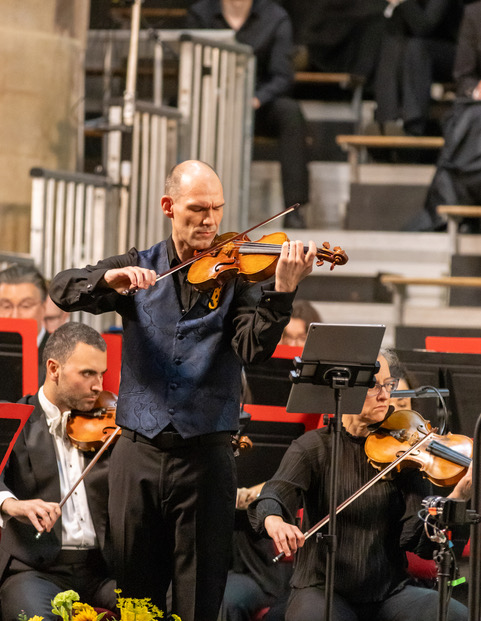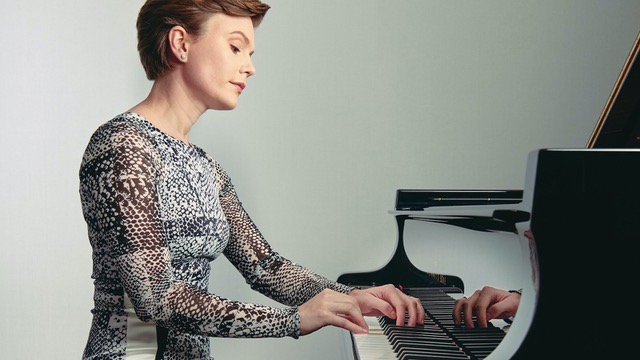theartsdesk at The Three Choirs Festival - Elgar, Vaughan Williams and Hammond | reviews, news & interviews
theartsdesk at The Three Choirs Festival - Elgar, Vaughan Williams and Hammond
theartsdesk at The Three Choirs Festival - Elgar, Vaughan Williams and Hammond
The most ancient festival continues to diversify, with mixed results

The Three Choirs is (are?) off again, for the 295th time, but with a very different look, even from the festivals of my youth, never mind 1715, or whenever the first one was held (there seems to be some doubt about it).
The big oratorio concerts in the cathedral are still there, but these days with a pulsating retinue of smaller concerts and recitals in a variety of other venues, not all of them in Gloucester, this year’s host city. Even oratorio life has a somewhat skewed appearance. Vaughan Williams’s Sancta Civitas is labelled “oratorio” but lasts a mere half-hour or so, while his Pilgrim’s Progress (of which more in a later review) is an opera, never intended for performance in church. True believers, in the oratorio sense, have to wait for the final concert, Elgar’s Apostles, to get their real fix. I shall not be there.
 I was there, and very happily so, for the opening concert, which was dominated, not by VW’s slightly pasty Sancta Civitas, but by Elgar’s Violin Concerto, in an unforgettable performance by Zsolt-Tihamér Visontay (pictured left) and the Philharmonia Orchestra under the festival’s artistic director Adrian Partington. No cathedral, least of all one as cavernous as Gloucester, is likely to be an ideal setting for a work as intricate and – in its marvellously insouciant way – sprawling as this great concerto. A good deal of Visontay’s obvious brilliance was spirited away into the vaults and triforium arches of Gloucester’s Norman nave. But what survived was a powerful essence, a kind of distillation, of the music’s emotional and architectural discourse.
I was there, and very happily so, for the opening concert, which was dominated, not by VW’s slightly pasty Sancta Civitas, but by Elgar’s Violin Concerto, in an unforgettable performance by Zsolt-Tihamér Visontay (pictured left) and the Philharmonia Orchestra under the festival’s artistic director Adrian Partington. No cathedral, least of all one as cavernous as Gloucester, is likely to be an ideal setting for a work as intricate and – in its marvellously insouciant way – sprawling as this great concerto. A good deal of Visontay’s obvious brilliance was spirited away into the vaults and triforium arches of Gloucester’s Norman nave. But what survived was a powerful essence, a kind of distillation, of the music’s emotional and architectural discourse.
I suppose, not being a conductor, that the great difficulty of accompanying this concerto lies in making sense of, and agreeing, its constant changes of tempo, its perpetual retreat into reflection. Idea after idea is presented like a gift, then gradually, often slowly, unwrapped. It’s not a work to listen to with a train to catch. It lingers too much (not unlike some trains, it’s true). But in a sympathetic performance it can draw one into its inner world in a way that most concertos, with their emphasis on theatre, never even attempt.
Visontay (familiar as the Philharmonia’s co-principal) and Partington, an underrated conductor in my opinion, judged this quality to something close to perfection after a slightly shaky-sounding first few bars, and kept a packed cathedral spellbound for little short of an hour. Yes, the finale cadenza, however beautifully played, is too long, too diverse; yes, there is a certain self-indulgence in the way the earlier movement themes come back, as if the finale’s own material were itself inconclusive. Elgar’s was an imperfect world, sometimes a world full of regret. But this performance proved, if anything, that untidiness of form can reveal interiors of feeling that tidiness conceals. For me it all but obliterated the shallow impression of the concert’s first half.
Sancta Civitas is emphatically not Vaughan Williams at his best, though it does in a sense offer a perfect image of his way of writing. Not to put too fine a point on it, it’s a bundle of VW clichés. It belongs to a period in the mid-twenties when the impulse of his pre-war and just post-war music seems to have faded a bit, and he is tending to fall back on mannerism. It’s music that one could almost write oneself, and it has in fact been much imitated. But it lacks sinew. Texts from Revelations are trotted out with a certain ceremony; a baritone soloist (Roderick Williams) interjects for no particular reason, then disappears; at the end a tenor soloist (Ruairi Bowen) materialises on the choir screen and intones, briefly, a clinching sentence – for its simplicity and clarity, the most beautiful moment of the whole work, and here the most beautifully sung.
But though the words are momentous, the music seems mostly not to matter enough. In the same sort of way, Rise up, O Sun!, a specially commissioned setting of Blake by Eleanor Alberga, which opened the concert, responds to these mystical exhortations in a rather conventional way, effective but somehow predictable – though, to be fair, the acoustics partly shrouded the music’s interior detail. The Festival Chorus and Cathedral Choirs did their duty by both works, with commitment and enthusiasm under the ever excellent Partington. But they dislodged no stones. As for the retinue, I made the sensible choice of Clare Hammond’s afternoon recital in the 1930s Gothic Holy Trinity Church in Longlevens. Hammond (pictured above) can be relied on to avoid anything that smacks of routine, and this recital was entirely typical. It kicked off with a series of études by Hélène de Montgeroult, a composer of the French revolutionary period whom she has been championing for some time – has even more or less reinvented – then tossed off all five of Ravel’s fiendish Miroirs as if they were grade 8 pieces, gave a nod to the classical repertoire in Beethoven’s Pathétique sonata, before winding up with three of Coleridge-Taylor’s attractive Negro Melodies and three of Albéniz’s extremely tricky Iberia pieces.
As for the retinue, I made the sensible choice of Clare Hammond’s afternoon recital in the 1930s Gothic Holy Trinity Church in Longlevens. Hammond (pictured above) can be relied on to avoid anything that smacks of routine, and this recital was entirely typical. It kicked off with a series of études by Hélène de Montgeroult, a composer of the French revolutionary period whom she has been championing for some time – has even more or less reinvented – then tossed off all five of Ravel’s fiendish Miroirs as if they were grade 8 pieces, gave a nod to the classical repertoire in Beethoven’s Pathétique sonata, before winding up with three of Coleridge-Taylor’s attractive Negro Melodies and three of Albéniz’s extremely tricky Iberia pieces.
Montgeroult is an intriguing figure, perhaps not quite (as Hammond claims) the missing link between Mozart and Chopin (what happened to Beethoven?), but clearly an estimable figure, something of a pioneer in the aestheticisation of the keyboard study, and particularly in the melodic treatment of mechanical passage-work, something one does, it’s true, associate particularly with Chopin. I know one or two of her piano sonatas, and they are disappointing. But the studies are another matter, beautifully conceived and worked, and a gift to a pianist of Hammond’s fluency and sheer musicality.
To follow all this with the Miroirs might strike one as lunacy, but Hammond played them with exquisite touch and brilliant colourings on a bright-topped Bösendorfer, finger-perfect, to my ears, like some latter-day Lipatti. Albéniz and Coleridge-Taylor were no less well served, and my sole regret was her sometimes too free rhythm in Beethoven, a composer who generally reacts badly to Latinisation. Maybe the Pathétique is simply too easy for this tirelessly questing artist. Or maybe she is simply incapable of dull conformity.
rating
Explore topics
Share this article
more Classical music
 Queyras, Philharmonia, Suzuki, RFH review - Romantic journeys
Japan's Bach maestro flourishes in fresh fields
Queyras, Philharmonia, Suzuki, RFH review - Romantic journeys
Japan's Bach maestro flourishes in fresh fields
 Classical CDs: Swans, hamlets and bossa nova
A promising young pianist's debut disc, plus Finnish mythology and a trio of neglected British composers
Classical CDs: Swans, hamlets and bossa nova
A promising young pianist's debut disc, plus Finnish mythology and a trio of neglected British composers
 Christian Pierre La Marca, Yaman Okur, St Martin-in-The-Fields review - engagingly subversive pairing falls short
A collaboration between a cellist and a breakdancer doesn't achieve lift off
Christian Pierre La Marca, Yaman Okur, St Martin-in-The-Fields review - engagingly subversive pairing falls short
A collaboration between a cellist and a breakdancer doesn't achieve lift off
 Ridout, Włoszczowska, Crawford, Lai, Posner, Wigmore Hall review - electrifying teamwork
High-voltage Mozart and Schoenberg, blended Brahms, in a fascinating programme
Ridout, Włoszczowska, Crawford, Lai, Posner, Wigmore Hall review - electrifying teamwork
High-voltage Mozart and Schoenberg, blended Brahms, in a fascinating programme
 Sabine Devieilhe, Mathieu Pordoy, Wigmore Hall review - enchantment in Mozart and Strauss
Leading French soprano shines beyond diva excess
Sabine Devieilhe, Mathieu Pordoy, Wigmore Hall review - enchantment in Mozart and Strauss
Leading French soprano shines beyond diva excess
 Špaček, BBC Philharmonic, Bihlmaier, Bridgewater Hall, Manchester review - three flavours of Vienna
Close attention, careful balancing, flowing phrasing and clear contrast
Špaček, BBC Philharmonic, Bihlmaier, Bridgewater Hall, Manchester review - three flavours of Vienna
Close attention, careful balancing, flowing phrasing and clear contrast
 Watts, BBC Symphony Orchestra and Chorus, Bignamini, Barbican review - blazing French masterpieces
Poulenc’s Gloria and Berlioz’s 'Symphonie fantastique' on fire
Watts, BBC Symphony Orchestra and Chorus, Bignamini, Barbican review - blazing French masterpieces
Poulenc’s Gloria and Berlioz’s 'Symphonie fantastique' on fire
 Bell, Perahia, ASMF Chamber Ensemble, Wigmore Hall review - joy in teamwork
A great pianist re-emerges in Schumann, but Beamish and Mendelssohn take the palm
Bell, Perahia, ASMF Chamber Ensemble, Wigmore Hall review - joy in teamwork
A great pianist re-emerges in Schumann, but Beamish and Mendelssohn take the palm
 First Persons: composers Colin Alexander and Héloïse Werner on fantasy in guided improvisation
On five new works allowing an element of freedom in the performance
First Persons: composers Colin Alexander and Héloïse Werner on fantasy in guided improvisation
On five new works allowing an element of freedom in the performance
 First Person: Leeds Lieder Festival director and pianist Joseph Middleton on a beloved organisation back from the brink
Arts Council funding restored after the blow of 2023, new paths are being forged
First Person: Leeds Lieder Festival director and pianist Joseph Middleton on a beloved organisation back from the brink
Arts Council funding restored after the blow of 2023, new paths are being forged
 Classical CDs: Nymphs, magots and buckgoats
Epic symphonies, popular music from 17th century London and an engrossing tribute to a great Spanish pianist
Classical CDs: Nymphs, magots and buckgoats
Epic symphonies, popular music from 17th century London and an engrossing tribute to a great Spanish pianist
 Sheku Kanneh-Mason, Philharmonia Chorus, RPO, Petrenko, RFH review - poetic cello, blazing chorus
Atmospheric Elgar and Weinberg, but Rachmaninov's 'The Bells' takes the palm
Sheku Kanneh-Mason, Philharmonia Chorus, RPO, Petrenko, RFH review - poetic cello, blazing chorus
Atmospheric Elgar and Weinberg, but Rachmaninov's 'The Bells' takes the palm

Add comment